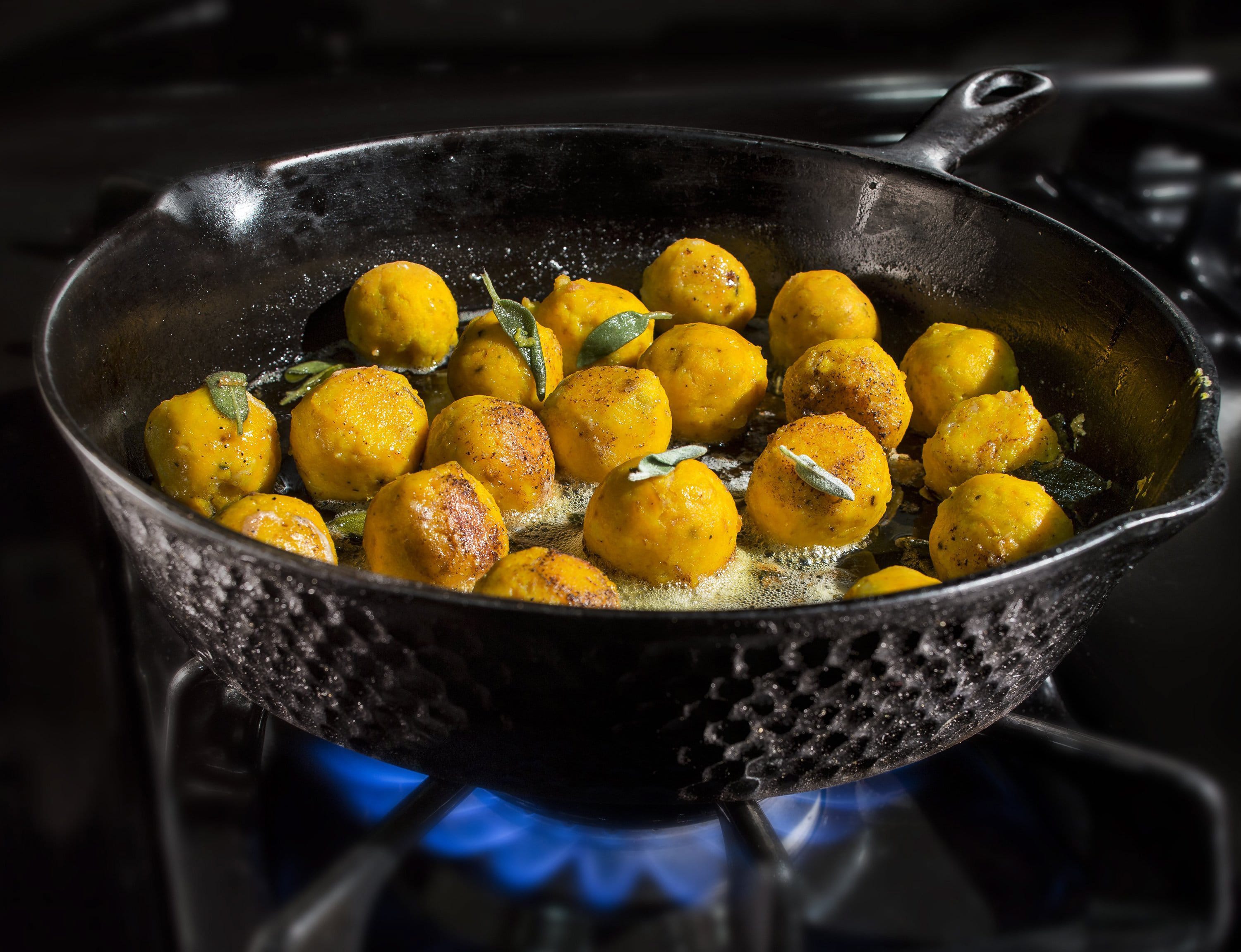You know how a word you’ve just learned suddenly pops up everywhere? Well, gnudi have been doing that lately, showing up on menus in restaurants I visit and in cookbooks I’ve been reading.
But just as that new vocabulary word was always out there but you hadn’t noticed it, gnudi have been around for centuries. I just hadn’t made them or even tasted them.
Gnudi (pronounced NYOO-dee) are little ricotta dumplings, best thought of as ravioli filling without the pasta. The Italian “gnudi” means “nudes,” so it’s like nude ravioli. They’re like gnocchi but much lighter and much easier.
With some super-fresh ricotta — essential for the best flavor — I took the plunge, following a recipe from “The Geometry of Pasta” by Caz Hildebrand and Jacob Kenedy.
The funny thing is, before finding that recipe, I scoured more than a dozen Italian cookbooks with no luck. I began to think gnudi might be a relatively new variation on ravioli. Instead, I found that they date from at least the late 1200s, according to Oretta Zanini de Vita in “Encyclopedia of Pasta,” and predate stuffed pasta.
It’s easy to see why gnudi stuck around. They came out tender and delicious. And although forming the little guys was time-consuming (a small spring-loaded cookie scoop, 1 or 2 teaspoon measure, helps), they were easy to make. Much less tricky than gnocchi or ravioli.
Since that batch, I’ve made gnudi frequently, varying the filling with spinach (a classic ingredient) and butternut squash. They’ve become a house favorite.
If you’ve shied away from making ravioli, what with forming the pasta dough, rolling, filling and cutting, maybe this is your warm-up. Or just make gnudi and forget the pasta.
Ricotta Gnudi
Makes: 20-30 gnudi, 4 servings
If the ricotta seems wet, let it drain in a sieve, about 30 minutes. Adapted from “The Geometry of Pasta” (Quirk, $24.95) by Caz Hildebrand and Jacob Kenedy.
1 cup whole milk ricotta
1/2 cup grated pecorino Romano, plus more for serving
1 egg
5-6 tablespoons fresh bread crumbs
salt
Dash of freshly grated nutmeg
Flour
Mix ricotta, pecorino Romano, egg and bread crumbs; season with 1/2 teaspoon salt and a dash of freshly grated nutmeg. Let sit so the bread crumbs thicken the mixture, 30 minutes.
Heat a large pot of well-salted water to a boil over high heat. Roll the dough into 20-30 small balls with well-floured hands, placing them on a floured baking sheet. You want plenty of flour on the outside of each ball to make a protective skin on the naked mixture.
Carefully slip them into the boiling water. After they bob to the surface, cook 2 minutes. Remove from pot with a slotted spoon. Serve with more pecorino or with a sauce of your choice.
Squash and Ricotta Gnudi
Makes: 20-30 gnudi, 4 servings
If the ricotta seems wet, let it drain in a sieve, about 30 minutes. Adapted from “The Geometry of Pasta” (Quirk, $24.95) by Caz Hildebrand and Jacob Kenedy.
3/4 cup whole milk ricotta
1/2 cup grated Parmesan, more for serving
1 egg yolk
1/2 cup fresh bread crumbs
salt
Dash freshly grated nutmeg
1/2 cup cooked, pureed butternut squash
Flour
Mix ricotta, Parmesan, egg yolk and bread crumbs; season with 1/2 teaspoon salt and a dash of freshly grated nutmeg.
If the squash is wet, allow it to drain. Precooked, frozen squash (defrosted and drained) works well in this recipe. Mix in squash.
Let sit 30 minutes so the bread crumbs thicken the mixture. Add more crumbs if dough seems wet.
Heat a large pot of well-salted water to a boil over high heat. Roll the dough into 20-30 small balls with well-floured hands, placing them on a floured baking sheet. You want plenty of flour on the outside of each ball to make a protective skin on the naked mixture.
Carefully slip them into the boiling water. After they bob to the surface, cook 2 minutes. Remove from pot with a slotted spoon. Serve with more Parmesan or with a sauce of your choice.
Spinach Gnudi
Makes: 30 gnudi, serves 4 as a main course or 6 as a starter
Adapted from “The Italian Cooking Course” (Kyle, $29.95) by Katie Caldesi.
12 ounces fresh spinach
8 ounces whole milk ricotta, drained
1 egg yolk
1/2 cup finely grated Parmesan, more for serving
1/2 cup flour
salt
1/2 teaspoon grated nutmeg
pepper
olive oil
1/2 stick salted butter
6 large fresh sage leaves
Steam spinach in a large pot until wilted. Allow to cool; squeeze to remove water. Chop it finely in a food processor. Mix in a bowl with ricotta, egg yolk, Parmesan, flour, 1/2 teaspoon salt, nutmeg, and pepper to taste.
Form small dumplings with your hands, using about 2 teaspoons mixture per dumpling. (Tightly pack the mixture so that it won’t break up in the water.) Place gnudi on a floured surface, making sure they don’t touch each other.
Heat a large pot of well-salted water to a boil over high heat; add the gnudi, in batches, being careful not to crowd them. After gnudi float to the surface, cook 2-4 minutes. Lift them out with a slotted spoon; transfer to a warm serving dish coated with a little olive oil to prevent sticking. Repeat with remaining gnudi.
For the sauce, melt butter with sage in a large skillet. Toss the cooked gnudi in the butter sauce. Serve, sprinkled with freshly grated Parmesan.



